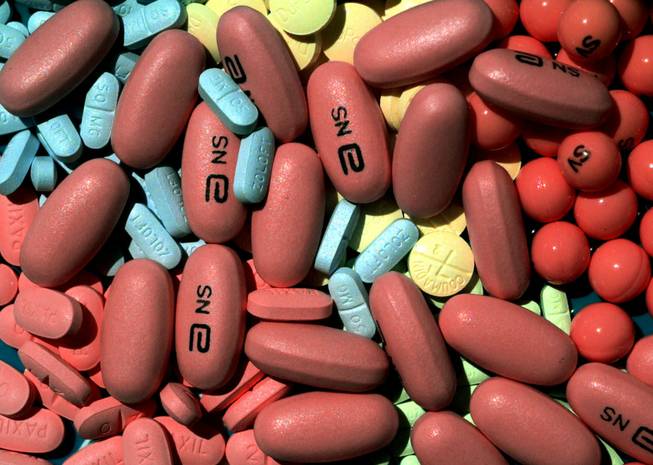
ASSOCIATED PRESS
An assortment of prescription drugs is seen at a pharmacy.
Tuesday, Dec. 17, 2013 | 2 a.m.
Sun coverage
If you think narcotics officers are singularly focused on drug pushers peddling heroin, methamphetamine and cocaine from street corners and dingy apartments, think again.
A multiagency drug-trafficking task force is devoting its entire two-day annual training conference in Las Vegas on the bigger problem: overdoses of drugs prescribed by doctors and sold at pharmacies.
Last year, 841 people in Clark County died of accidental drug overdoses, the majority of which involved prescription drugs, Coroner Mike Murphy said.
“What most people don’t seem to grasp is that folks who are abusing substances are literally on the edge of death,” he said. “You don’t know what your overdose level is. It’s different for everyone.”
Participants in the High Intensity Drug Trafficking Area, a task force representing local, state and federal law enforcement agencies, spent Monday discussing the need to build greater collaboration among law enforcers, educators and treatment providers to curb the growing abuse of prescribed drugs. Today, they were scheduled to discuss what law enforcement tactics and strategies need to be employed to tackle the problem.
Greater scrutiny of physicians prescribing these drugs is one — but not the only — aspect of prevention, officials said.
A federal grand jury last week indicted Las Vegas doctor Victor Bruce, 48, on a charge of conspiracy to distribute a controlled substance. Prosecutors allege Bruce, a pain management specialist, prescribed large amounts of oxycodone while conspiring with local drug dealers to distribute the drugs within the Las Vegas Valley.
“It’s not new,” said Paul Rozario, special agent in charge of the Drug Enforcement Administration’s Las Vegas district office. “Prescription drug abuse has been a problem in American society for decades; however, easy accessibility and the increased strength of many of these drugs — specifically pain medications — has caused its abuse to be widespread.”
Authorities say prescription drug abuse cuts across every age, race and socioeconomic category, affecting residents at all ends of the valley and across the country, as well. The DEA lists prescription drug abuse as the fastest-growing drug problem in the United States.
The surge in painkiller addictions has led to an increased demand for heroin, which is sometimes a cheaper and more accessible alternative to prescription drugs.
Medical providers at publicly funded facilities in Nevada treated 266 people for pharmaceutical-related addictions in 2006, Rosario said. By 2012, that number had jumped to 616.
Treatment of heroin addicts in Nevada also increased from 607 people in 2006 to 931 last year.
“I don’t think it’s going to get any better until it gets worse, but, unfortunately, I think we don’t have that much more time,” Rozario said. “We are at epidemic proportions right now.”
One challenge is users’ mentality about taking prescription drugs. Murphy theorizes that many prescription drug addicts deny they have a problem because they are not buying illicit drugs off the street.
To combat the complexity of the problem, community stakeholders will need to fully grasp the big picture of the issue, Murphy said.
“I don’t think there’s going to be one solution,” he said. “It has to be a combination of enforcement and education and community awareness.”

Join the Discussion:
Check this out for a full explanation of our conversion to the LiveFyre commenting system and instructions on how to sign up for an account.
Full comments policy